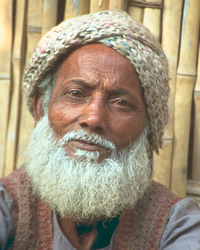South Asian, Bengali-speaking in Malaysia

Photo Source:
COMIBAM / Sepal
|
Send Joshua Project a map of this people group.
|
| People Name: | South Asian, Bengali-speaking |
| Country: | Malaysia |
| 10/40 Window: | Yes |
| Population: | 623,000 |
| World Population: | 5,091,400 |
| Primary Language: | Bengali |
| Primary Religion: | Islam |
| Christian Adherents: | 0.00 % |
| Evangelicals: | 0.00 % |
| Scripture: | Complete Bible |
| Ministry Resources: | Yes |
| Jesus Film: | Yes |
| Audio Recordings: | Yes |
| People Cluster: | South Asia Muslim - other |
| Affinity Bloc: | South Asian Peoples |
| Progress Level: |
|
Introduction / History
The Bengali began migrating to Malaysia during the early 20th century. They were mainly from Calcutta, Dacca, Chittagong, and Midnapore areas of Bengal in India. Being well educated, the Bengali secured supervisory or medical assistant positions in the Malaysian plantations.
Today's third generations of Bengali are mostly professionals in a variety of fields. The Bengali is a small community, yet they have maintained their Bengali language and rich cultural practices. Marriages are still arranged by parents, with consent from the potential couple. Marriages are often arranged with Bengali from other countries. A growing number of interracial marriages among other races and other languages are influencing this close-knit community. Their community is multi-lingual. As part of a larger North Indian Hindu community living in Malaysia, the Bengali often join Punjabi Hindus, Sindhi Hindus, and Gujarati Hindus in many celebrations and temple functions. They are well-versed in Hindi and often use Hindi or English on such occasions. The younger generation is comfortable using English and Malay, although Bengali is still being used at home.
What Are Their Beliefs?
There are approximately 2,500 Bengali Hindus living in Malaysia. Together they celebrate three major Bengali Festivals: Durga Pooja (worship of the goddess of supreme power) usually in October; Kali Pooja (worship of the goddess of destruction) celebrated during Deepavali (a Hindu festival of lights celebrating good over evil) in November; and Poila Boishakh (Bengali New Year) celebrated in April. Durga Pooja is celebrated every year from the 4th to the 9th day of Navaratri (a nine day festival dedicated to the three main deities Durga, Lakshmi, and Saraswati celebrated by Hindus observing prayers and fasting) in October. The goddess Durga is worshiped as the Divine Mother rather than a god of supreme power during Durga Pooja. During the festival prayers, devotional songs, and evening festivities will take place each day. On the 8th day, young girls who have not reached puberty are worshiped and are likened to the Divine Mother. On the 10th (and final) day, devotees dip clay statues of the Divine Mother into the sea to signify that she is part of the universe once more. Finally, those celebrating will join in Bijoya Dashami (a grand feast for victory) where differences and grievances are forgiven and forgotten between friends and family and rejoicing takes place for the next five days. Lakhi or Lakshmi Pooja (the worship of the goddess of wealth) is celebrated on the 15th day after Navaratri. The Bengali fast until the next day for the prosperity of their community.
What Are Their Needs?
There are social issues that need to be addressed among the younger generations of Bengali. There are groups that have been formed to ensure that the present youth and future generations do not lose touch with their rich cultural heritage, beliefs, and language. Bengali language classes are being held for adults and children who wish to learn.
Prayer Points
Pray that their efforts to maintain their cultural heritage will not further isolate them.
Pray for committed believers who will be sensitive both to the Bengali culture and their spiritual needs as well.